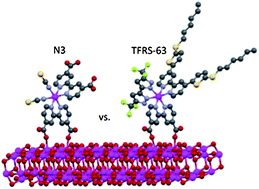Ru(ii) sensitizers bearing dianionic biazolate ancillaries: ligand synergy for high performance dye sensitized solar cells†
Abstract
We report on a new series of Ru(II) sensitizers, TFRS-61–66, suited for high performance

* Corresponding authors
a
Department of Chemistry and Low Carbon Energy Research Center, National Tsing Hua University, Hsinchu 30013, Taiwan
E-mail:
ychi@mx.nthu.edu.tw
b
Institute of Chemical Research of Catalonia (ICIQ), Avda. Països Catalans 16, 43007 Tarragona, Spain
E-mail:
jnclifford@iciq.es
c ICREA, Avda. Lluís Companys 28, Barcelona E-08030, Spain
d
Department of Chemistry and Center for Emerging Material and Advances Devices, National Taiwan University, Taipei 10617, Taiwan
E-mail:
chop@ntu.edu.tw
We report on a new series of Ru(II) sensitizers, TFRS-61–66, suited for high performance

 Please wait while we load your content...
Something went wrong. Try again?
Please wait while we load your content...
Something went wrong. Try again?
H. Yeh, S. Ho, Y. Chi, J. N. Clifford, E. Palomares, S. Liu and P. Chou, J. Mater. Chem. A, 2013, 1, 7681 DOI: 10.1039/C3TA10988G
To request permission to reproduce material from this article, please go to the Copyright Clearance Center request page.
If you are an author contributing to an RSC publication, you do not need to request permission provided correct acknowledgement is given.
If you are the author of this article, you do not need to request permission to reproduce figures and diagrams provided correct acknowledgement is given. If you want to reproduce the whole article in a third-party publication (excluding your thesis/dissertation for which permission is not required) please go to the Copyright Clearance Center request page.
Read more about how to correctly acknowledge RSC content.
 Fetching data from CrossRef.
Fetching data from CrossRef.
This may take some time to load.
Loading related content
